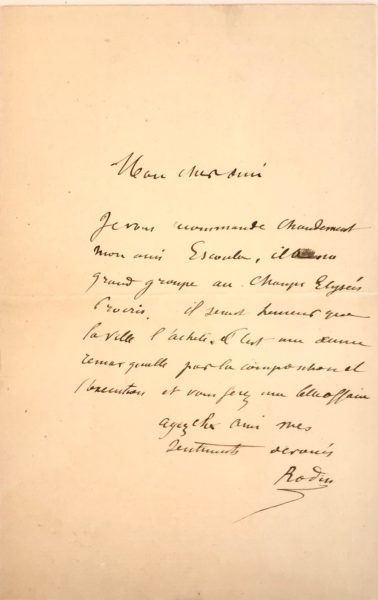The box with your note arrived according to your instructions and I saw the Stone Statue with attention, it’s [sic] proportions seemed just and there was a resemblance to nature throughout highly creditable to the sculptor (who if I apprehend your account of him) has had no advantages of study, he possesses a talent which if cultivated would afford both honor and profit.
If I had any engagements in my profession which required the assistance this person could give I should readily employ him on the character you have given, but I have no work of the kind, but I cannot help thinking in the numerous new buildings both public and private, Grecian and Gothic his abilities might be employed until he has determined in what branch of Art to settle himself.
I beg you will present my particular respects and best wishes for her health and happiness to the worthy Mrs. Macintosh whose friendly attentions I always remember with pleasure, and I will beg the favour also that you will say to Mr. G. Macintosh I hope he will oblige us with more of his company when he comes to town in case he can spare it from more pressing concerns…”

John Flaxman self portrait
In 1770, Flaxman, whose father was a producer of plaster casts, began his training at the Royal Academy, of which the esteemed painter Joshua Reynolds was president. Flaxman worked for English potter Josiah Wedgwood while perfecting his technique, becoming a successful sculptor of funerary monuments, especially bas-reliefs inspired by his close study of Greek Classicism. During the 1780s he worked and studied in Rome, refining his style and producing illustrations for works by Homer, Dante and Aeschylus for which he would become famous. Despite his renown as an illustrator, Flaxman continued to create church memorials as well as teach sculpture at London’s Royal Academy.
Macintosh was a successful Scottish chemist and inventor best known for developing a waterproof fabric from the petroleum distillate naphtha. The appellation “Mackintosh” or “Mac” as a term for a raincoat acknowledges his innovation. Our friendly letter sends greetings to the scientist’s wife Mary née Fisher (?-?) and his son George Macintosh (1791-1848).
Heavily folded with several visibly repaired tears and three small holes at the folds’ intersection. Written in Flaxman’s elegant, though aging, hand. Uncommon.






